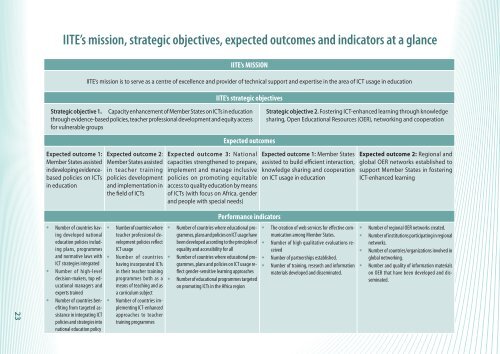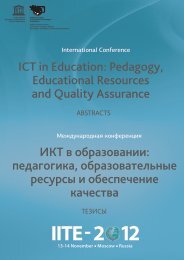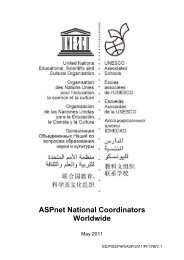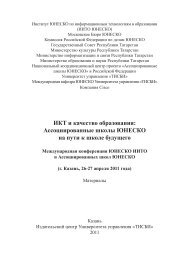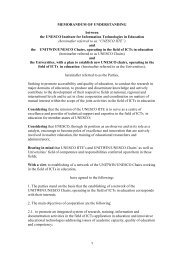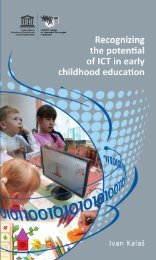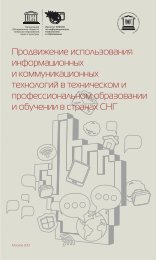Download PDF version - unesco iite
Download PDF version - unesco iite
Download PDF version - unesco iite
You also want an ePaper? Increase the reach of your titles
YUMPU automatically turns print PDFs into web optimized ePapers that Google loves.
23<br />
IITE’s mission, strategic objectives, expected outcomes and indicators at a glance<br />
IITE’s MISSION<br />
IITE’s mission is to serve as a centre of excellence and provider of technical support and expertise in the area of ICT usage in education<br />
IITE’s strategic objectives<br />
Strategic objective 1. Capacity enhancement of Member States on ICTs in education<br />
through evidence-based policies, teacher professional development and equity access<br />
for vulnerable groups<br />
Expected outcome 1:<br />
Member States assisted<br />
in developing evidencebased<br />
policies on ICTs<br />
in education<br />
• Number of countries having<br />
developed national<br />
education policies including<br />
plans, programmes<br />
and normative laws with<br />
ICT strategies integrated<br />
• Number of high-level<br />
decision-makers, top educational<br />
managers and<br />
experts trained<br />
• Number of countries benefi<br />
ting from targeted assistance<br />
in integrating ICT<br />
policies and strategies into<br />
national education policy<br />
Expected outcome 2:<br />
Member States assisted<br />
in teacher training<br />
policies development<br />
and implementation in<br />
the fi eld of ICTs<br />
• Number of countries where<br />
teacher professional development<br />
policies refl ect<br />
ICT usage<br />
• Number of countries<br />
having incorporated ICTs<br />
in their teacher training<br />
programmes both as a<br />
means of teaching and as<br />
a curriculum subject<br />
• Number of countries implementing<br />
ICT-enhanced<br />
approaches to teacher<br />
training programmes<br />
Expected outcomes<br />
Expected outcome 3: National<br />
capacities strengthened to prepare,<br />
implement and manage inclusive<br />
policies on promoting equitable<br />
access to quality education by means<br />
of ICTs (with focus on Africa, gender<br />
and people with special needs)<br />
Performance indicators<br />
• Number of countries where educational programmes,<br />
plans and policies on ICT usage have<br />
been developed according to the principles of<br />
equality and accessibility for all<br />
• Number of countries where educational programmes,<br />
plans and policies on ICT usage refl<br />
ect gender-sensitive learning approaches<br />
• Number of educational programmes targeted<br />
on promoting ICTs in the Africa region<br />
Strategic objective 2. Fostering ICT-enhanced learning through knowledge<br />
sharing, Open Educational Resources (OER), networking and cooperation<br />
Expected outcome 1: Member States<br />
assisted to build effi cient interaction,<br />
knowledge sharing and cooperation<br />
on ICT usage in education<br />
• The creation of web services for eff ective communication<br />
among Member States.<br />
• Number of high qualitative evaluations received<br />
• Number of partnerships established.<br />
• Number of training, research and information<br />
materials developed and disseminated.<br />
Expected outcome 2: Regional and<br />
global OER networks established to<br />
support Member States in fostering<br />
ICT-enhanced learning<br />
• Number of regional OER networks created.<br />
• Number of institutions participating in regional<br />
networks.<br />
• Number of countries/organizations involved in<br />
global networking.<br />
• Number and quality of information materials<br />
on OER that have been developed and disseminated.


